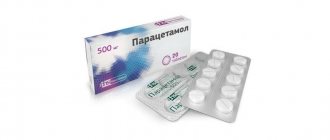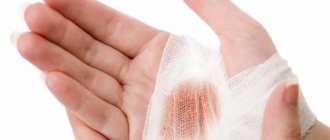Hemostatic (antihemorrhagic, hemostatic) drugs are a group of drugs that are used to stop bleeding (hemorrhages) and prevent excessive blood loss.
Normally, blood is a fluid liquid - a suspension of formed elements (erythrocytes, leukocytes, platelets) in plasma. However, during bleeding, blood is able to change its rheological (fluid) properties - it becomes excessively thick and viscous, and then solidifies at the site of damage to the vessel wall (coagulates), forming a clot (thrombus). The thrombus closes the lumen of the wound and thereby prevents further bleeding and loss of blood from the body.
In case of extensive bleeding or in diseases that are accompanied by a violation of the formation of blood clots, the blood does not have time or is not able to clot in time. This leads to excessive blood loss, and then to shock, oxygen starvation of organs (especially the brain and heart) and the development of various kinds of negative consequences, including death. In this case, hemostatic drugs are used.
Indications for use
Hemostatic drugs are used for conditions associated with blood clotting disorders and bleeding.
Fibrinolysis inhibitors are used to stop severe bleeding during operations (especially on the heart, lungs, large vessels), extensive injuries, birth hemorrhages, reduced blood clotting in liver diseases, as well as in case of overdose of fibrinolytic drugs (fibrinolysin, streptokinase, alteplase, urokinase, tenecteplase and etc.).
Aprotinin is additionally used for diseases of the pancreas: acute pancreatitis (including alcoholic), severe injuries and pancreatic cancer.
Vitamin K preparations are used for bleeding associated with vitamin K deficiency in the body: hemorrhagic syndrome of newborns, liver diseases (cholelithiasis and obstructive jaundice) and intestinal diseases (enterocolitis, Crohn's disease). In addition, vitamin K preparations are used for bleeding caused by an overdose of indirect anticoagulants - warfarin, acenocoumarol, phenindione.
Herbal hemostatics are indicated for uterine bleeding (menorrhagia), minor bleeding from small vessels of the stomach and intestines.
Hemostatic drugs for local use are used to stop capillary and parenchymal bleeding (from internal organs) during open abdominal operations.
Etamsylate is used for the prevention and treatment of surgical bleeding, as well as for uterine, nosebleeds, bleeding gums due to periodontal disease, and gingivitis.
Eltrombopag and recombinant thrombopoietin are indicated for the treatment of idiopathic thrombocytopenic purpura - a chronically low level of platelets in the blood, which is dangerous due to frequent bleeding - when the spleen is removed.
Emicizumab is used to treat hemophilia, an inherited disease associated with blood clotting disorders and life-threatening bleeding.
Clotting factor drugs are used for severe, extensive bleeding, as well as for the treatment of hemophilia.
From the history of hemostatic agents
Medicinal herbs that have a hemostatic effect have been known for centuries.
Shepherd's purse, yarrow, and nettle leaves were used by ancient healers as hemostatic agents. The hemostatic effects of peppermint tincture, decoction of viburnum bark, and plantain leaves have long been known. Since time immemorial, dry moss has been applied to an open wound. But herbs hardly solved the problem, and mortality from blood loss remained high. More effective means were required, but things were not moving quickly. Only in 1883 did scientific research lead the French biologist G. Hayem to the discovery of the platelet. In 1890 , the role of calcium in blood clotting was proven. in 1916 and described in 1918 . In 1931 , a Canadian veterinarian accidentally discovered warfarin, an indirect anticoagulant. The main physiological anticoagulant, protein C, was discovered and described in 1976. Once the enemy is identified, it is easier to fight it. The sequential discovery and description of the action of three anticoagulants allowed scientists to begin the development of new hemostatic agents. Since the late 60s of the last century, the production of effective hemostatic drugs gradually began. Today medicine has a wide variety of modern hemostatic agents.
Classification of hemostatic drugs
Hemostatic drugs are classified into:
- fibrinolysis inhibitors: amino acids (tranexamic acid, aminocaproic acid), protease inhibitors (aprotinin);
- vitamin K preparations: menadione, phytomenadione;
- herbal preparations: liquid extract of water pepper, nettle leaves, yarrow herb;
- hemostatic agents for local use: thrombin, fibrinogen, Ambien, calcium chloride;
- other hemostatic drugs for systemic use: etamsylate, eltrombopag, emicizumab, recombinant thrombopoietin.
In addition, preparations of proteins that regulate blood coagulation - coagulation factors II, VII, VIIa, VIII, IX, X and their combinations, von Willebrand factor, nonacog alpha - have a hemostatic effect.
Hemostasis in periapical surgery
When performing periapical surgery, it is important to achieve adequate hemostasis in the surgical field. Stopping and minimizing bleeding allows for clear visualization of the work area, reduces overall operative time, optimizes resection, preparation and retrograde filling, and reduces potential bone loss and the amount of swelling after surgery. However, there is no consensus in the literature about which of the known hemostatic agents is the best. Kim and Rethnam in 1997 determined that a good hemostatic agent should stop bleeding in a short period of time, be easy to use, biocompatible, not interfere with wound healing, and be relatively inexpensive. The purpose of this article is to analyze known methods and materials that are used to control bleeding during surgery in the maxillofacial area.
Bleeding control
Hemostatic agents that are available on the market today differ greatly in their mechanism of action, effectiveness and overall effect on the human body.
Bone wax
Bone wax is a non-absorbable material consisting of beeswax (88%) and isopropyl palmitate (12%). It is applied to the bone walls under pressure, and its mechanism of action is mechanical tamponade of the bone spaces. Due to its transparent consistency and deep penetration into the bone tissue structure, it is very difficult to remove from the working field.
Ferrous sulfate and calcium sulfate
The mechanism of action of ferrous sulfate is chemical and involves the coagulation of proteins. In essence, this effect is similar to tissue cauterization. Lemon and Jeansonne, studying the effect of ferrous sulfate on the lower jaw of a rabbit, came to the conclusion that this material provides fairly good hemostasis. Scarano et al, comparing the hemostatic efficacy of 20% ferrous sulfate, calcium sulfate, and gauze packing, summarized that calcium sulfate also provided good control of bleeding.
Adrenalin
Sympathomimetic amine vasoconstrictors have long been used in periapical surgery as topical agents to control bleeding (Figures 1-8).
Photo 1. X-ray before performing periapical intervention.
Photo 2. Clinical appearance before surgery.
Photo 3. View before using a hemostatic agent.
Photo 4. Gauze soaked in epinephrine was placed into the bone perforation and held there under pressure for 2 minutes.
Photo 5. Hemostasis after the use of adrenaline.
Photo 6. Assessment of the quality of retrograde filling through endoscopic control.
Photo 7. Suturing the wound without tension.
Photo 8. Periapical radiograph after periapical intervention.
Epinephrine produces a vasoconstrictive effect by stimulating α-adrenergic receptors. Besner, however, suggested that the use of epinephrine in periapical surgery may cause systemic effects on the human cardiovascular system. Vickers, in turn, comparing the hemostatic effectiveness and potential cardiovascular effects of ferrous sulfate and racemic epinephrine swabs, concluded that both of these agents provided good control of bleeding and did not cause significant impairment of normal cardiac function. In a similar study, Vy also summarized that adrenaline-infused collagen sponges provided superior dryness to the work area without causing changes in blood pressure or heart rate.
Aluminum chloride
In 2001, von Arx and colleagues proposed the use of a paste consisting of aluminum chloride and kaolin, which had previously been used for gingival retraction, as a hemostatic agent. The researchers applied various hemostatic agents to the tibiae of 6 rabbits: bone wax, ferrous sulfate (Stasis), aluminum chloride (Expasyl), and a combination of Expasyl and Stasis, and concluded that Expasyl alone or in combination with Stasis was the most effective hemostatic agent.
Jensen et al, using the same study design, compared 5 different hemostatic methods (Expasyl and Stasis; Expasyl, Stasis and boron refreshment; Spongostan; Spongostan and epinephrine; electrocautery) and concluded that the most effective approaches were the use of combinations of Expasyl and Stasis (P < 0.05), and electrocautery. Menendez-Nieto, comparing the hemostatic efficacy of epinephrine and aluminum chloride in 99 patients, concluded that aluminum chloride provided superior clinical results (P < 0.05; Figures 9-14).
Photo 9. Clinical appearance before surgery.
Photo 10. Aluminum chloride was applied with a spatula into the bone perforation and remained there for 2 minutes.
Photo 11. Hemostasis after the use of aluminum chloride. Removal of the surface layer of bone tissue.
Photo 12. Assessing the quality of retrograde filling using an endoscope.
Photo 13. Suturing the wound without tension.
Photo 14. View 1 year after periapical surgery.
Other agents and methods
Gelatin-based absorbable sponges, oxidized cellulose, electrocautery, carbon dioxide laser, chitosan, and plant-based hemostatic agents may also be used for hemostasis. However, the scientific basis for the use of these methods is not deep enough. As for side effects, in cases of bone wax, the formation of an additional layer of connective tissue in the area of hemostasis is sometimes noted instead of bone regeneration. Obviously, due to the fact that it is not possible to scrape off the entire portion of the wax. Thus, the overall healing period and the risk of infection of the intervention area also increases. When using wax and aluminum chloride, the results of histological studies indicate the development of an inflammatory reaction in the tissues. Therefore, before closing the wound, it is recommended to curettage the bone surface or treat it with rotary instruments.
Jensen and colleagues found that aluminum chloride and electrocautery cause adverse tissue reactions (necrotization, inflammation, decreased regeneration levels). However, in cases of subsequent removal of the superficial layer of bone, such complications were not observed. Peñarrocha-Diago et al noted that sometimes in patients for whom aluminum chloride was used as a hemostatic agent, the volume of edema was greater than in those for whom vasoconstrictors were used for the same purpose. When ferrous sulfate was used, normal wound healing was observed with a slight foreign body reaction. But to achieve this result, the authors recommend curettage of the bone cavity and irrigation of the intervention area with saline solution. If the hemostatic agent is not completely removed, a non-foreign body reaction develops in 2 out of 10 cases. It provokes a slowdown in the healing process, and in some cases, the formation of an abscess. When using calcium sulfate, epinephrine, resorbable gelatin sponges and chitosan, no side effects developed.
Conclusion
Bleeding control is a key factor influencing the success of periapical surgical procedures. The hemostatic agent must be biocompatible, easy to manipulate, and able to stop bleeding in a short period of time. Ferrous sulfate and aluminum chloride have proven themselves as hemostatic agents. However, after hemostasis at the final stages of the intervention, the surface of the bone tissue should always be refreshed. At the same time, calcium sulfate and epinephrine are hemostatic agents that do not provoke the development of a non-foreign body reaction.
By: Isabel Menendez Nieto Juan Cervera Ballester Maria Penarrocha Diago David Penarrocha Oltra








